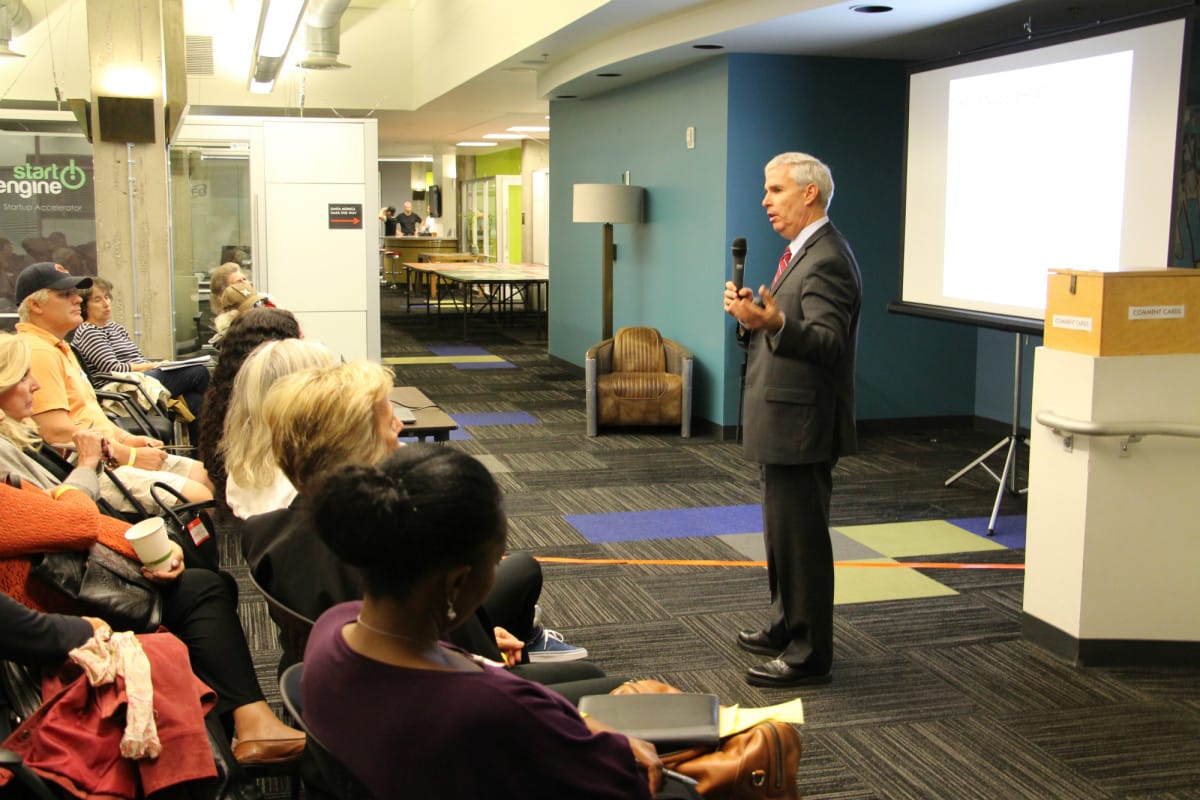
Did you know that in the last 13 years, the number of people biking in Santa Monica increased 356 percent? Or that in the last three years, 45 miles of bike lanes, share rows, and other facilities have been installed throughout the city?
How about the fact that Santa Monica has one of the only library systems in the state that consistently earns a five-star rating from Library Journal Index? Or that Santa Monica’s crime rate is lower than it has been since the early 1950s?
These are just some of the facts presented to those who attended Santa Monica Talks, a series of three community events hosted by the City Manager’s office and held over the course of two weeks this month to help acquaint those who live and work in the city with the success — and challenges — facing the community.
While there were many successes to be celebrated, City Manager Rod Gould also emphasized the importance of creating a city that is sustainable for future generations to come.
“We commit to sustainability. It is our obligation as this generation to use the resources… in Santa Monica in such a way that it does not compromise the ability of future generations to achieve their goals,” Gould told the crowd at Real Office Center in Downtown Santa Monica Thursday.
Gould, who is retiring in January after five years as the City Manager, outlined the challenges facing the city, especially when it comes to creating housing affordable to middle- and low-income families.
“At this point we have nothing else in the pipeline,” said Gould, referring to the lack of pending affordable housing projects. From July 2013 to July 2014, 375 new affordable residences were built, according to Gould, but since voters rejected the affordable housing funding ballot initiative, Measure H, in November, the City has no money to fund new affordable housing.
“We’re quickly becoming a city and a society of haves and have-nots,” said Gould, adding that he believes the middle class to be the “rudder” of American society. “The loss of the middle class means losing our way,” he added.
Nationally, young adults are struggling to find housing they can afford in the locations where there are economic opportunities, and Santa Monica, where the rents are the highest in the county, is no exception.
“We need to think about sustainability writ large. That doesn’t just mean environmental sustainability,” he said. “It’s also economic stability, so that there is commerce and jobs and opportunities, and social equity, so that there are opportunities for all.
“When we are making big decisions as a community, we ought not just think about folks who have been here forever or new folks,” he said. “We need to think about those who haven’t shown up yet, those who haven’t been born, those who haven’t come to Santa Monica yet. We ought to be thinking in terms of three generations.”
In the face of the many challenges, however, Gould remains optimistic. Crime is down, as is unemployment. Facing a historic drought, the City is taking steps to cut back on water use, including implementing mandatory water reduction targets for residents and businesses alike.
Santa Monica is on target to meet its 100 percent water self-sufficiency goal by 2020 and is moving toward a zero-waste target by 2030, Gould said. A booming tourist industry and growing tech startup sector helped Santa Monica end the financial year about $28 million in the black, despite external financial pressures from increasing public employee pension payments and the loss of redevelopment agency money.
Three years after the Bike Action Plan was adopted, about 45 new miles of bike lanes and sharerows have been installed throughout the city, and Santa Monica is currently drafting a Pedestrian Action Plan in the same model. Recently, the City Council voted to move forward with what could be the region’s first public bike share program, scheduled to come online summer 2015, providing visitors and residents alike with a cheap, clean, and healthy way of connecting to the Expo Light Rail, phase II of which is on schedule to open to the public in 2016.
“We should be a beacon city. Cities like Santa Monica that have such great resources, such talent, such assets, should be lighting the way for other cities,” said Gould. “By the time it’s 2050, three-quarters of the human race will live in cities, so as cities go, so goes human civilization. Santa Monica needs to be one of those cities that thinks big, that sets big goals, that experiments, that takes risks.”







